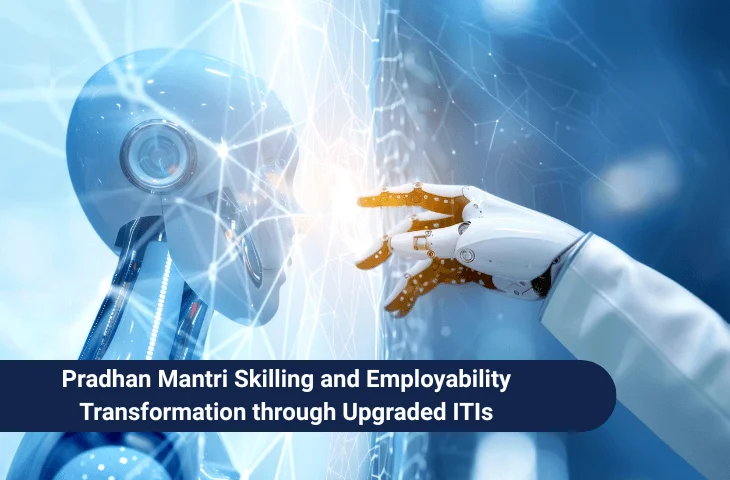Pradhan Mantri Skilling and Employability Transformation through Upgraded ITIs (PM-SETU) is a landmark scheme initiated by the Government of India on 4th October 2025. With a budget of ₹60,000 crore for the 2025–2028 period, the scheme aims to modernize and upgrade 1,000 Government Industrial Training Institutes (ITIs) across India.
Why was PM-SETU Launched?
The central objective is to equip youth with advanced, industry-relevant skills to make them employable at both national and international levels. By integrating modern infrastructure, industry partnerships, and innovative learning methods, PM-SETU intends to transform ITIs into centres of excellence for skill development.
How will PM-SETU Transform ITIs Across India?
The scheme adopts a hub-and-spoke model, which is central to its implementation strategy:
| Feature | Hubs | Spokes |
| Number of ITIs | 200 | 800 |
| Role | Centres of Excellence | Outreach and access expansion |
| Infrastructure | State-of-the-art infrastructure, innovation & incubation centres, production units | Standard ITI infrastructure linked to hubs |
| Training Focus | Training-of-trainers, advanced skill courses | Skill training for students in surrounding regions |
| Placement Support | Yes, dedicated placement services | Limited or coordinated through hubs |
| Innovation & Incubation | Innovation centres and start-up support | No dedicated innovation centres |
| Connectivity | Central hub connecting multiple spokes | Linked to a hub (average of 4 spokes per hub) |
| Target Students | All students in cluster, including advanced learners | Students from regional and remote areas |
This model ensures a government-owned but industry-managed system, where Special Purpose Vehicles (SPVs) and anchor industry partners manage clusters to deliver outcome-based training aligned with market demand.
Also Check: List of Government Schemes of India
What are the Key Features of PM-SETU?
PM-SETU has several key components that make it unique and forward-looking:
- Industry-Aligned Curriculum: Courses are designed in collaboration with industries, ensuring that students acquire skills that meet current market needs.
- Diverse Learning Options: The scheme offers a mix of long-term diplomas, short-term certifications, and executive programs to cater to various learners.
- Innovation and Incubation: Hubs will feature innovation centres to encourage students to develop new products and start-ups.
- Global Partnerships: Five National Skill Training Institutes (NSTIs) in Bhubaneswar, Chennai, Hyderabad, Kanpur, and Ludhiana will be strengthened as Centres of Excellence with global collaboration from entities like the World Bank and Asian Development Bank.
- Modern Infrastructure: Hubs and spokes will feature advanced digital learning tools, production units, and state-of-the-art equipment to provide hands-on training.
- Cluster Management: SPVs will be responsible for coordinating hub-and-spoke clusters with anchor industries to ensure industry-relevant training outcomes.
Which ITIs will be Transformed in the First Phase?
The first phase of PM-SETU focuses on key locations including Patna and Darbhanga in Bihar, along with other selected clusters across India. Fifteen hub-and-spoke clusters have been identified initially to serve as model centres, which will later be expanded to cover all 1,000 Government ITIs.
These clusters will not only enhance access to quality skill training but also act as inspiration for regional youth to pursue vocational education aligned with employment opportunities.
Check Out: Complete List of Important Schemes for NABARD Grade A Exam
How does PM-SETU Align with National Skill Development Goals?
PM-SETU is part of India’s broader strategy to enhance youth employability and create a skilled workforce. It complements initiatives like:
- STRIVE (Skills Strengthening for Industrial Value Enhancement): Focused on improving infrastructure and training quality in ITIs.
- Model ITIs and ESDI (Enhancing Skill Development Infrastructure in North East States): Aimed at improving training infrastructure and accessibility.
- Vocational Skill Labs in Schools: PM-SETU aligns with the establishment of 1,200 vocational skill labs in Navodaya Vidyalayas and Eklavya Model Residential Schools across India, bridging early skill development with advanced ITI-level training.
What are the Benefits for Students from PM SETU?
PM-SETU directly benefits students by:
- Providing industry-oriented training, ensuring graduates are employable in high-demand sectors.
- Offering hands-on experience through production units, innovation labs, and digital learning systems.
- Creating pathways for entrepreneurship, with incubation centres supporting start-ups.
- Offering short-term and long-term courses suitable for students with varying academic backgrounds.
- Expanding training to remote areas through spoke ITIs.
Get ready to crack government job exams with leading educators
How is PM-SETU Funded and Supported?
The ₹60,000 crore scheme is centrally funded with co-financing support from global partners like the World Bank and Asian Development Bank. The funding ensures that:
- ITIs receive modern infrastructure.
- Industry partnerships are strengthened.
- Innovation and incubation facilities are developed.
- Teachers are trained for advanced technical education.
How does PM-SETU Integrate with Other Youth-Focused Initiatives?
PM-SETU is part of a larger ₹62,000 crore package launched in October 2025 aimed at youth education, skilling, and entrepreneurship. Complementary initiatives include:
| Initiative | Key Details | Beneficiaries |
| Mukhyamantri Nishchay Svyam Sahayata Bhatta Yojana (Bihar) | Provides ₹1,000 monthly allowance for two years along with free skill training | Around 5 lakh graduates in Bihar |
| Jan Nayak Karpoori Thakur Skill University | Offers industry-oriented courses and vocational education | Students seeking vocational and skill-based education in Bihar |
| New Academic Facilities (PM-USHA) | New infrastructure including academic and research facilities | Over 27,000 students in four universities in Bihar |
| Vocational Skill Labs | 1,200 labs established in schools focusing on 12 high-demand sectors (IT, electronics, agriculture, tourism, etc.) | Students in Navodaya Vidyalayas and Eklavya Model Residential Schools across 34 States/UTs |
| Bihta Campus of NIT Patna | Equipped with 5G labs, Regional Academic Centre for Space (ISRO collaboration), and Innovation & Incubation Centre | Students of NIT Patna (capacity 6,500), start-up ecosystem participants |
How will Industry Participation Enhance PM-SETU’s Effectiveness?
Industry participation is crucial for PM-SETU’s success:
- SPVs and Anchor Partners: Each cluster is managed by SPVs in collaboration with anchor industry partners to ensure training matches industry standards.
- Outcome-Based Training: Curricula are co-created with industries to ensure students gain skills that are in demand.
- Placement and Entrepreneurship Support: Industry partners assist in placements and guide student-led start-ups, bridging the gap between education and employment.
This collaboration ensures that ITIs evolve into modern skill centres that are both government-owned and industry-managed.
How does PM-SETU Strengthen National Skill Training Institutes (NSTIs)?
Five NSTIs Bhubaneswar, Chennai, Hyderabad, Kanpur, and Ludhiana will be developed as Centres of Excellence, offering:
- Advanced courses in vocational and technical training.
- Modern infrastructure to host global collaborations.
- Innovation and entrepreneurship opportunities for students.
- Teacher training to improve the quality of vocational education across India.
These NSTIs will serve as role models for the ITI ecosystem, ensuring consistent quality across all centres.
What is the Expected Impact of PM-SETU on India’s Workforce?
PM-SETU aims to produce a workforce that is:
- Globally competitive in key industrial sectors.
- Equipped with practical, hands-on skills.
- Capable of entrepreneurship and innovation.
- Well-prepared for both domestic and international employment opportunities.
Key Takeaways
| Feature | Details |
| Scheme Name | Pradhan Mantri Skilling and Employability Transformation through Upgraded ITIs (PM-SETU) |
| Launch Date | October 2025 |
| Budget | ₹60,000 crore (2025–2028) |
| Focus | Modernizing 1,000 Government ITIs across India |
| Model | Hub-and-Spoke (200 hubs, 800 spokes) |
| Hubs | Equipped with advanced infrastructure, innovation centres, training units, placement services |
| Spokes | Focus on regional outreach and access to skill training |
| Industry Role | SPVs with anchor industry partners to ensure outcome-based training |
| Global Support | Co-financed by World Bank & Asian Development Bank |
| NSTIs | Strengthened as Centres of Excellence in Bhubaneswar, Chennai, Hyderabad, Kanpur, Ludhiana |
| First Phase Focus | Patna and Darbhanga ITIs |
Also Read:
Questions Based on PM SETU
- What does PM-SETU stand for?
a) Pradhan Mantri Skill Enhancement Training Unit
b) Pradhan Mantri Skilling and Employability Transformation through Upgraded ITIs
c) Pradhan Mantri Skill Education and Training Union
d) Pradhan Mantri Skill and Technology Upgrade
e) None of the above
Answer: b - What is the total budget allocated to PM-SETU?
a) ₹50,000 crore
b) ₹60,000 crore
c) ₹62,000 crore
d) ₹45,000 crore
e) ₹55,000 crore
Answer: b - How many ITIs will be upgraded under PM-SETU?
a) 500
b) 1,000
c) 1,500
d) 2,000
e) 800
Answer: b - Which model is adopted by PM-SETU?
a) Single-centre model
b) Hub-and-spoke model
c) Franchise model
d) Cooperative model
e) None of the above
Answer: b - How many hubs are planned under PM-SETU?
a) 100
b) 150
c) 200
d) 250
e) 300
Answer: c - Which institutions are strengthened as Centres of Excellence?
a) IITs
b) IIMs
c) NSTIs
d) NITs
e) AIIMS
Answer: c - Which global partners co-finance PM-SETU?
a) IMF & WTO
b) World Bank & Asian Development Bank
c) OECD & UNDP
d) ADB & IMF
e) UNDP & World Bank
Answer: b - Which state ITIs are focused in the first phase?
a) Mumbai & Pune
b) Patna & Darbhanga
c) Chennai & Hyderabad
d) Ludhiana & Kanpur
e) Bhubaneswar & Jaipur
Answer: b - What is the primary aim of PM-SETU?
a) Build new universities
b) Modernize ITIs and enhance employability
c) Offer scholarships to school students
d) Create vocational labs in schools only
e) Fund private colleges
Answer: b - Which of the following is NOT a feature of PM-SETU?
a) Hub-and-spoke model
b) Anchor industry partnerships
c) Global co-financing
d) Free primary education
e) Innovation and incubation centres
Answer: d
- MISHTI Scheme, India’s Initiative to Restore Mangrove Ecosystems
- National Green Hydrogen Mission Features, Objectives, and Benefits
- Paramparagat Krishi Vikas Yojana, Transforming India’s Organic Farming
- Mission on Integrated Development of Horticulture NHM and HMNEH
- Swachh Bharat Mission, India’s Journey Towards Cleanliness and Hygiene
- SAGY, A Step Towards Holistic Development of Indian Villages

Hi, I’m Aditi. I work as a Content Writer at Oliveboard, where I have been simplifying exam-related content for the past 4 years. I create clear and easy-to-understand guides for JAIIB, CAIIB, and UGC exams. My work includes breaking down notifications, admit cards, and exam updates, as well as preparing study plans and subject-wise strategies.
My goal is to support working professionals in managing their exam preparation alongside a full-time job and to help them achieve career growth.
